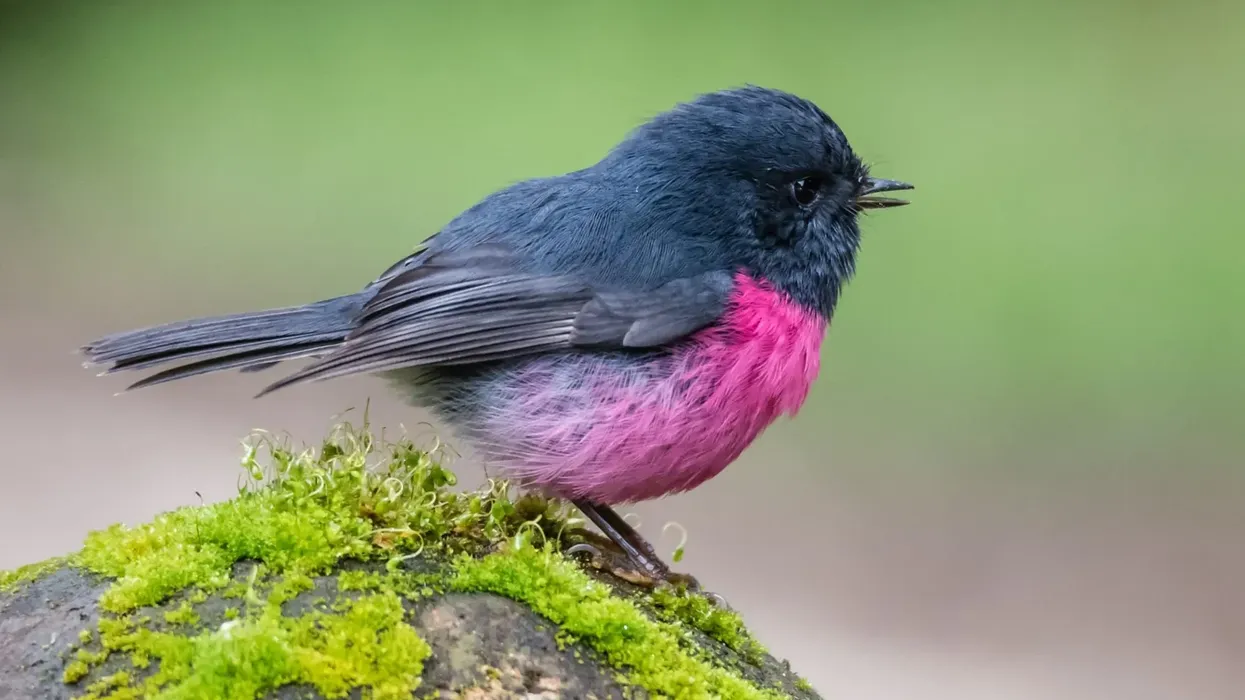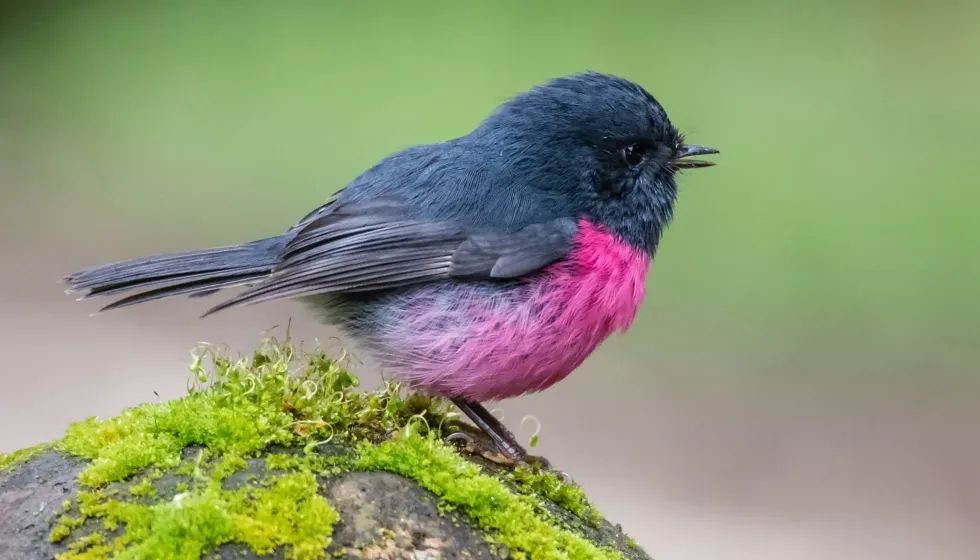The pink robin (Petroica rodinogaster) belongs to the Petroicidae family, and the males have a dark grayish-black back, throat, head, wings, and pink chest. In contrast, females have olive-brown upperparts and pink-colored tints.
The pink robin's range is spread among southern Australia. Tasmania, New South Wales, and the cool temperate forests of southern Victoria are a few of the pink robin bird locations. American and European robins, other birds of the robin species have a red-colored belly and are quite common.
Let's take a look at these pink robin facts and information, and if you enjoy these then, do read about other bird species such as the avocet and the green-winged teal for more amazing information.
Pink Robin Interesting Facts
What type of animal is a pink robin?
The pink robin (Petroica rodinogaster) is an Australian bird.
What class of animal does a pink robin belong to?
The pink robin (Petroica rodinogaster) belongs to the class Aves. They are a species of Australian birds that have a pinkish belly.
How many pink robins are there in the world?
The total population of pink robin (Petroica rodinogaster) birds has not been estimated yet, but it is assumed that more than 10,000 of them are in the world.
Where does a pink robin live?
Pink robins are strictly restricted to southeastern Australia, which means that they are only found in Australian rainforests and open grasslands (in winter). They are also seen in Tasmania, New South Wales, and King and Flinders Islands.
What is a pink robin's habitat?
Pink robins live in their natural habitat, which is rain forests or temperate forests during the summers, but they prefer open and dry grasslands during winter.
Who do pink robins live with?
Pink robins are not very social birds; most of the time, they are spotted alone, but they are seen in pairs during the breeding season.
How long does a pink robin live?
The lifespan of a pink robin (Petroica rodinogaster) is still unknown as they live in deep rainforests and are hard to be studied, but since they are a species of robin birds, we can assume that their life span is a maximum of five to six years.
How do they reproduce?
The pink robin (Petroica rodinogaster) mates twice in its breeding season in moist forests of Australia. They build their nest nearly 15 ft (4.5 m) above the ground.
Their nest looks like a deep cup of moss, lined with soft grass. Pink robins lay three to four eggs, and their eggs are bluish, grayish, or greenish-white with lavender-colored spots. They hatch in around 15-16 days.
The female tends to take care of the eggs; she is responsible for taking care of the young hatchling, while the male is responsible for feeding her and taking care of her during the breeding and incubation period.
What is their conservation status?
The conservation status of the pink robin (Petroica rodinogaster) is listed as Least Concern. This means that they do not have any grave threats, but their population might take a hit in the future as humans are cutting down and destroying their main habitats, which are rainforests and temperate forests.
Pink Robin Fun Facts
What do pink robins look like?
The pink robin (Petroica rodinogaster) has a dark blackish-gray head, back, throat, wings, and tail. Males have a pink breast and a white belly, while a female pink robin (Petroica rodinogaster) has olive-brown upperparts and a cinnamon lower body with a tint of pink on the breast.
How cute are they?
The pink robin (Petroica rodinogaster) birds are fluffy, small, and round and are found in Australia. They are really cute, and because of their pink breast, they appear more attractive to humans.
How do they communicate?
The pink robin (Petroica rodinogaster) makes a calm, chattering sound to communicate with other birds. As compared to its European and American cousin, it is quieter, and its sound is similar to the sound of a twig breaking. The pink robin (Petroica rodinogaster) makes a chattering short trill 'chwit-tr-tr-tr-tr' sound.
How big is a pink robin?
The pink robin (Petroica rodinogaster) is a Petroicidae, and like its European relatives, it is quite small in size. It is only 4.7-5.1 in (12-13 cm) in length. The pink robin (Petroica rodinogaster) is about twice or thrice the size of a giant ichneumon wasp, one of the insects that it preys upon.
How fast can a pink robin fly?
Due to its natural habitat and distribution, the pink robin (Petroica rodinogaster) is really hard to study. And because of this fact, it has not been recorded how fast a pink robin (Petroica rodinogaster) can fly.
How much does a pink robin weigh?
A pink robin (Petroica rodinogaster) is a small and lightweight bird. It weighs only 0.3-0.4 oz (9-11 g). You will barely feel its weight if you hold one in your hand, that is, if you are lucky enough to see and catch one.
What are the male and female names of the species?
The pink robin male and the pink robin female do not have any separate names. However, there is a slight difference in the appearance of males and females. Males have blackish-gray upperparts and females have olive-brown upperparts; though there isn't much difference, you can differentiate if you look closely.
What would you call a baby pink robin?
Like all other baby birds, a baby pink robin (Petroica rodinogaster) is called a hatchling. During the breeding season, a female lays three to four eggs which hatch in around 16 days.
What do they eat?
Pink robins are carnivores. They feed on insects such as spiders, caterpillars, and beetles. They prefer to catch insects roaming on the ground among the leaves rather than catching their prey mid-air. One of the main animals that eat the pink robin is a hawk.
Are they friendly?
Pink robins are small and calm Australian birds. There haven't been any reports where a human has been attacked by a pink robin (Petroica rodinogaster), so it is safe to assume that pink robins are harmless to humans.
Would they make a good pet?
Pink robins are a rare sight to the eyes. They live in the rain forests, and if you want to see one, you have to get close to their natural habitat. It is not suitable to have them as pets as they are wild animals.
Did you know...
A pink robin lays eggs twice a year, and each clutch contains three to four eggs. The eggs are bluish, greenish, or grayish-white in color and have lavender and dark brown-colored spots on the larger end.
The pink robin (Petroica rodinogaster), also known as a pink breasted robin or a pink chest robin, was discovered in the year 1819 by the Belgian naturalist Auguste Drapiez.
Other than the pink robin, the red-capped robin is also found in southern and western Australia. But there aren't any European robins or American robins in Australia. Both have red-colored breasts, so they might also be called red robin, not found in Australia.
Unlike the European robin, which is easier to spot, the pink robin does not show itself much. It tries to hide and avoid human interaction; thus, it is really difficult to take photographs of a pink robin.
What does the pink robin use to build its nest?
Pink robin uses moss and barks to build their deep cup-shaped nest. They use a spider's webbing to hold the moss and bark together and use feathers or fur to make it comfortable.
The females take responsibility for building the nest, and it uses a lichen to camouflage it and to make the nest look similar to the tree or bush it is built on. Their nest is around 15 ft (4.5 m) above the ground on a tree.
What are a pink robin's courtship rituals?
Males are shy and do not have much confidence. Unlike other male birds, they do not hover or perform flight songs to attract the female.
Instead, it relies more on its pink-colored breast and belly to attract a female for mating. They do not display the confident breeding antics of most birds but rather rely mostly on their lurid pink chest and belly to lure in a mate.
Here at Kidadl, we have carefully created lots of interesting family-friendly animal facts for everyone to discover! Learn more about some other birds from our military macaw facts and sanderling facts pages.
You can even occupy yourself at home by coloring in one of our free printable robin coloring pages.










